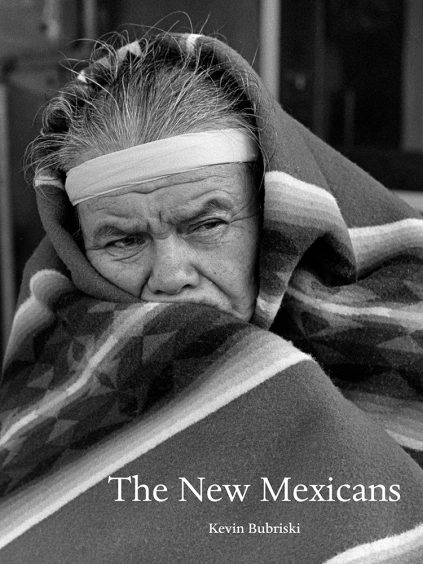-
Archives
- February 2025
- April 2024
- June 2022
- April 2021
- April 2020
- October 2019
- July 2019
- April 2018
- October 2017
- April 2017
- July 2015
- January 2015
- September 2014
- May 2013
- April 2013
- February 2013
- January 2013
- November 2012
- October 2012
- September 2012
- April 2012
- January 2012
- September 2011
- August 2011
- July 2011
- June 2011
- May 2011
- March 2011
- January 2011
- November 2010
- September 2010
- July 2010
- May 2010
- March 2010
- January 2010
- November 2009
- September 2009
- July 2009
- May 2009
- March 2009
- January 2009
- November 2008
- September 2008
- July 2008
- May 2008
-
Meta
The New Mexicans, 1981–83
The New Mexicans, 1981–83
by Kevin Bubriski
Foreword by Bernard Plossu
Essay by Matthew J. Martinez, Ph.D.
Museum of New Mexico Press
December 2024
A follow-up to Bubriski’s best-selling Look into My Eyes: Nuevomexicanos por Vida, ’81–’83 (Museum of New Mexico Press 2016), which was a photographic documentation of Hispanic New Mexicans, this book expands the lens to include Native Americans and Anglos living in Albuquerque, Santa Fe, and various northern New Mexico villages. There is an insider intimacy to these photographs that portrays a gritty, authentic sense of reality that is neither disturbing nor challenging.
These images are at once timeless as well as deeply evocative of the period, with a universality that will appeal to wider audiences, as more people have discovered the enduring appeal of New Mexico’s unique culture over the last forty-plus years.
“In only two years in the state—time spent mainly in Santa Fe, Albuquerque, and parts north—Kevin Bubriski embraced New Mexico and its people. He photographed everything from tattooed manitos making pilgrimage to the Santuario de Chimayó to traditionally attired Pueblo dancers in ancient plazas, from carefully coiffed politicians courting voters to cowboys in full regalia readying to ride. Even photographs taken inside prison walls are alive with the feisty spirit of the people. For longtime New Mexicans, Bubriski’s photographs brim with nostalgia and ring with a sense of innocence. But undercurrents of historical trauma, social inequity, poverty, and environmental degradation have always haunted the state, and Bubriski’s images reveal shadows here and there: young boys in a bleak concrete flood-control structure with ‘Free Us’ scrawled in graffiti behind them; a heavily burdened man hitchhiking beside the highway on a freezing day; men scavenging through dumpsters; weed-strewn, overgrazed landscapes.
The New Mexicans, 1981–83 will also captivate those not acquainted with the state, providing insight into the eccentricities and cultural richness of northern New Mexico and the diverse characters who call it home.”—Don J. Usner
“Historically, New Mexico’s cultural traditions, peoples, and landscapes have inspired photographers and artists, and Indigenous peoples throughout the Southwest have been some of the most photographed and documented people in the United States. Kevin Bubriski’s photographs of Pueblo dances and ceremonies are part of this long tradition of image making and image taking. With the publication of this book, they become an act of reciprocity, returning to the peoples and communities from which they originated.”—Matthew J. Martinez, from his essay
Kevin Bubriski is a documentary photographer and Guggenheim Fellow whose photographs are in the permanent collections of The San Francisco Museum of Modern Art, the Museum of Modern Art, the Metropolitan Museum of Art, and the Bibliothéque national de France, among others. His books include The Uyghurs: Kashgar before the Catastrophe (George F. Thompson Publishing); Legacy in Stone: Syria before War (powerhouse Books); Pilgrimage: Looking at Ground Zero (powerhouse Books); Nepal: 1975–2011 (Peabody Museum Press and Radius Books); and Portrait of Nepal (Chronicle Books). He lives in Vermont.
Matthew J. Martinez, Ph.D is an educator dedicated to education about and the protection of heritage sites. He previously served as First Lieutenant Governor at Ohkay Owingeh Pueblo and has researched and published in the areas of Pueblo history, documentary filmmaking, and cultural production. Martinez is currently Executive Director of the Mesa Prieta Petroglyph Project, a nonprofit land stewardship organization in northern New Mexico.
Bernard Plossu is a French photographer whose many books include Le voyage mexicain: 1965–1966 (Contrejour); New Mexico Revisited (University of New Mexico Press); ¡Vámonos! Bernard Plossu in Mexico (Aperture); and Western Colors (Thames & Hudson). His work has been widely exhibited around the world and is included in the permanent collections of the Albuquerque Museum, the Center for Creative Photography, Tucson, the Centre Pompidou, Paris, The Museum of Fine Arts, Houston, the San Francisco Museum of Modern Art, and the Institut Valencià d’Art Modern, Valencia, Spain. Born in Vietnam, Plossu lives in La Ciotat, France.
A thirteenth generation New Mexican, Don J. Usner was born in Embudo, New Mexico, and grew up in Los Alamos and in Chimayó. He earned an M.A. in cultural geography at the University of New Mexico and has since written several books, including Sabino’s Map: Life in Chimayó’s Old Plaza; Chasing Dichos Through Chimayó, Benigna’s Chimayó: Cuentos from the Old Plaza; and (with William deBuys) Valles Caldera: A New Vision for New Mexico’s National Preserve. His photographs have appeared in The New Yorker, The New York Times, the Los Angeles Times, Land and People, El Palacio, and New Mexico Magazine, among others. Usner’s writing and photography reflect his long and intimate association with the land and people of Northern New Mexico.


